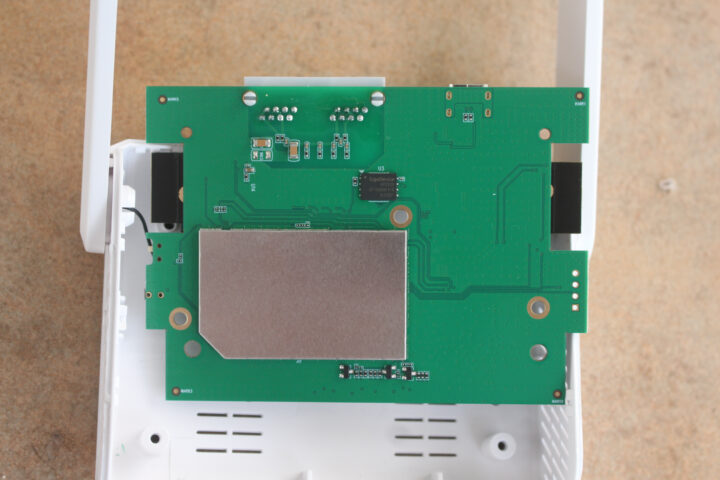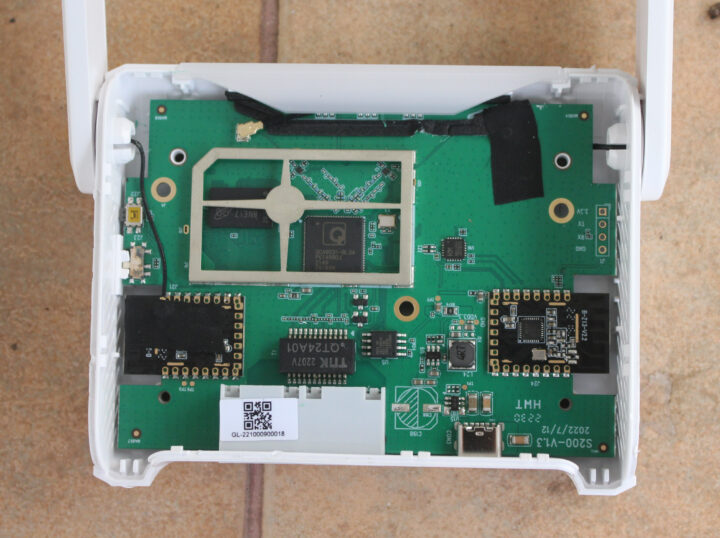GL.iNet are better known for their routers, but the company is also offering IoT gateways and Smart Home hubs such as the GL-S10 BLE to MQTT IoT gateway. The company is now preparing to launch the GL.iNet GL-S200 Thread Border Router in early April, and I’ve been asked to do some beta testing before launch, so GL.iNet have sent me a kit with the GL-S200 and three Thread development boards acting as IoT nodes.
A Thread Border Router acts as a WiFi or/and Ethernet gateway connecting to battery-powered Thread sensor nodes equipped with a low-power 802.15.4 radio. In this first post, I’ll go through the hardware and specifications, before reporting my finding in a separate post next week.
GL-200 Thread Border Router kit unboxing and specifications
The development boards are all identical and they were each kept in an antistatic bag. But let’s open the GL-S200 package first.
The Thread Border Router ships with a 5V/2A power adapter with US, EU, and UK plug adapters, an Ethernet cable, a Quick Start Guide, and another paper with some basic troubleshooting instructions, a link to the documentation, and support channel that include email, Facebook, or a Forum.
The rear panel comes with a WAN and a LAN port, and a USB Type-C port for power.
The front has an LED “bar” for status, and two external antennas, one on each side. Note the plastic is slightly damaged because I took the photo above and below after the teardown…
One of the sides features a reset pinhole and a Mode switch each to select Thread or Bluetooth LE mode, so just like the GL-S10, it can also function as a BLE to MQTT bridge.
GL-200 specifications:
- SoC – Qualcomm QCA9531 MIPS WiFi 4 processor @ up to 650 MHz
- System Memory – 128MB DDR2
- Storage – 128MB NAND flash
- Networking and Wireless
- 1x 10/100M Ethernet WAN port
- 1x 10/100M Ethernet LAN port
- 2.4 GHz Wi-Fi 4 802.11b/g/n up to 150 Mbps
- Thread and Bluetooth 5.0
- Misc – Reset button, toggle “Mode” button for Thread/BLE selection, Tri-color LED indicator light
- Power Supply – 5V/2A via USB Type-C port
- Power Consumption – Less than 4 Watts typ.
- Dimensions – 118 x 85 x 30mm
- Weight – 108 grams
- Temperature Range – Operating: 0 to 40°C; storage: -20 to 70°C
The gateway runs OpenWrt 21.02 with a Linux 5.4 kernel.
Let’s now have a look at the Thread Dev boards included with the kit.
Those are called “Thread Dev Board A0” and are fitted each with an add-on board with a potentiometer+button, a PIR sensor, and two RGB LEDs.
If we take out the “Thread Dev Board A1” add-on board we’ll see more details about the main board based on a module with Nordic Semi nRF52840 Cortex-M4F multiprotocol microcontroller. The board can be powered by a coin cell battery or its USB Type-C port and comes with a few LEDs, a Reset button, two user-programmable buttons, and a switch to select battery or USB port.
GL.iNet did not provide the Thread Dev Board specifications except for the dimensions (A0: 78.5×27.5×11.5 mm; A1: 45x28x37 mm) and weight (78 grams), but we do have a pinout diagram.

GL-S200 Thread Border Router teardown
Let’s check out the GL-S200 hardware since we are not told what chip is used for Thread in the Border Router itself and to find out more details about the hardware design.
As usual, the teardown starts from the bottom of the device which also has a sticker with the information to get connected. This includes the default IP address, the default SSID (matching the last three digits of the MAC address to make sure more than one Border Router can operate within the range), the Key/password “goodlife”, the MAC, serial number, and Device ID. The GL-S200 has already passed FCC certification (FCC ID: 24FIW-S200).
We’ll need to take out the rubber pads, and remove four screws, before attempting to open the device. It was harder than most of the devices that go through my hands, and I did scratch the case a little bit and broke one of the clips.
The S200-V1.3 is fitted with two modules based on the Silicon Labs MG21 multiprotocol, Zigbee, Thread, and Bluetooth mesh networking Arm Cortex-M33 microcontroller. One relies only on its PCB antenna, and the other is also connected to one of the external antennas. We learn that one of the MG21 modules is for Bluetooth LE and the other for Thread in the pinout diagram shared for the board.
The other antenna should be for WiFi using the electronics hidden under a metal shield for EMC/EMI compliance. People interested in messing with the OS will also find a 4-pin UART header on the left side of the board.
We can take out of the board by removing three more screws, and the bottom side of the board has another shield as well as a GigaDevice AP2220 chip which does not show up in web searches at all. I eventually found out it’s a 1Gbit (128MB) NAND flash, and the part number is on the third line on the markings: GD5F1GQ5UE.
I had to use a bit more force-brute to pop out the shield, but there’s not much to see on that side of the board.
If we repeat the procedure on the top of the board, we’ll indeed find the Qualcomm QCA9531 MIPS Atheros processor and a Micron SDRAM.
That will be all for today. While the GL.iNet GL-S200 Thread Border Router will officially be launched in early April, it’s already possible to pre-order the kit I’ve received for beta testing for $154.00 plus shipping. But if you already have your own Thread node, then the GL-S200 alone is sold for $79 during the pre-order period, after which it will be $99.
I’ve already powered the GL-S200 and the Thread Dev Boards with USB, and I’ll have some more reading to do to add the Dev Boards to the dashboards, access the sensor/potentiometer data, and control the RGB LED in the second part of the “review”.
Continue reading “Getting Started with GL-S200 Thread Border Router kit“.

Jean-Luc started CNX Software in 2010 as a part-time endeavor, before quitting his job as a software engineering manager, and starting to write daily news, and reviews full time later in 2011.
Support CNX Software! Donate via cryptocurrencies, become a Patron on Patreon, or purchase goods on Amazon or Aliexpress



















Good catch on the SPI-NAND!
I only found out after removing the shield on the Qualcomm processor and not seeing a flash device.
Is the OpenWRT used on this product open source?
If so, it will be a lot of fun to hacking.
All of the most recent Apple, Google, Amazon Home devices have a thread border router inside.
Worst router brand ever, slow, heats up easily causing a cpu throttle and half baked software. i recommend everyone to steer clear.
It’s amazing how QCA9531 still shows up in new products. It’s probably still the best supported SoC family in OpenWRT, but it’s also really old now, having been announced 10 years ago as a mild refresh of the 2007 ar7xxx/ar9xxx SoC family, and using the same mips 24k core that is now nearly 20 years old and competed with ARM926EJ.
Hello from Slovenia!